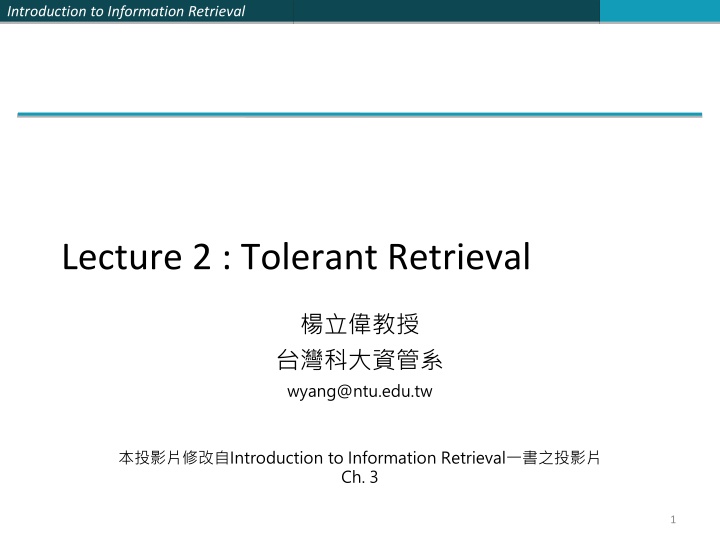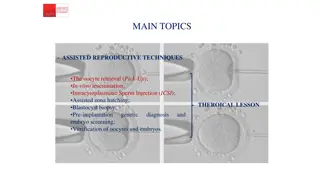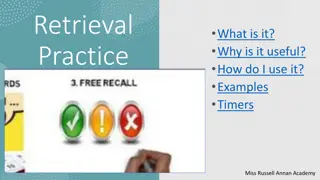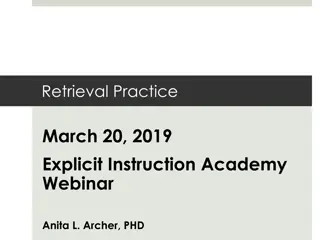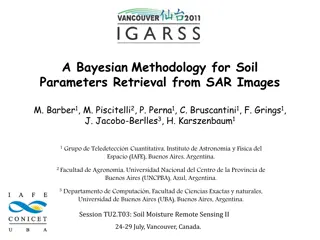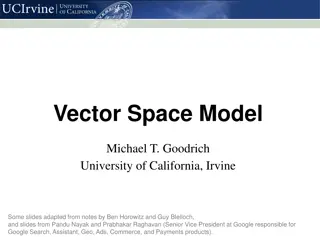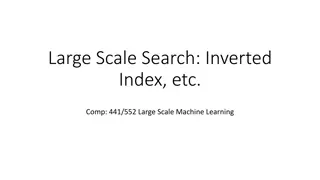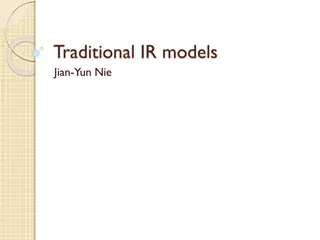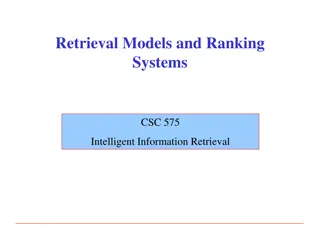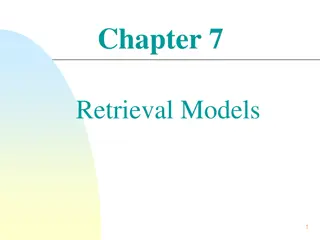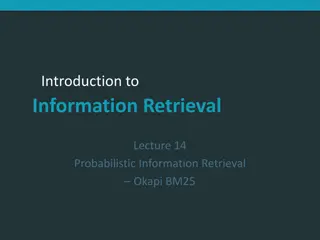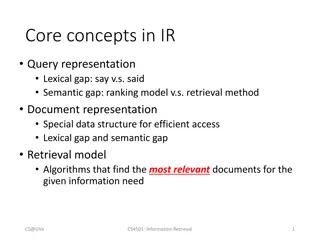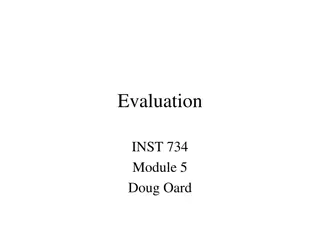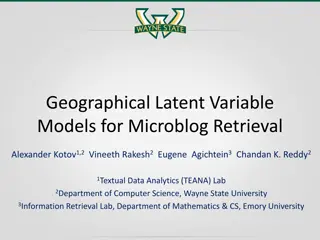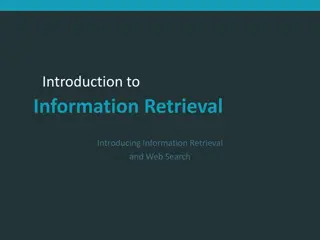Comprehensive Overview of Information Retrieval Techniques
This comprehensive overview delves into information retrieval concepts such as tolerant retrieval, inverted index, intersecting posting lists, and spelling correction. It also explores how Google utilizes the Boolean model for search queries and discusses various methods for spelling correction in documents and user queries, including isolated word and context-sensitive correction algorithms.
Download Presentation

Please find below an Image/Link to download the presentation.
The content on the website is provided AS IS for your information and personal use only. It may not be sold, licensed, or shared on other websites without obtaining consent from the author.If you encounter any issues during the download, it is possible that the publisher has removed the file from their server.
You are allowed to download the files provided on this website for personal or commercial use, subject to the condition that they are used lawfully. All files are the property of their respective owners.
The content on the website is provided AS IS for your information and personal use only. It may not be sold, licensed, or shared on other websites without obtaining consent from the author.
E N D
Presentation Transcript
Introduction to Information Retrieval Lecture 2 : Tolerant Retrieval wyang@ntu.edu.tw Introduction to Information Retrieval Ch. 3 1
Introduction to Information Retrieval Recap : Inverted Index For each term t, we store a list of all documents that contain t. dictionary postings 2 2
Introduction to Information Retrieval Intersecting two posting lists 3 3
Introduction to Information Retrieval Inverted index with position 1 2 3 4 5 pos Doc1: Doc2: and ( =1) 3 1:1 1:5 2:1 3 1:1 1:5 2:1 2 1:2 2:2 2 1:2 2:2 Dictionary in Hashtable or Tree/Trie 2 1:3 2:3 2 1:3 2:3 1 1:4 1 1:4 1 2:4 1 2:4 1. ( )( ) ( )( ) 2. Inverted List (posting) Doc1
Introduction to Information Retrieval Google use the Boolean model, too On Google, the default interpretation of a query [w1 w2. . .wn] is w1AND w2AND . . .AND wn Simple Boolean retrieval returns matching documents in no particular order. Google (and most well designed Boolean engines) rank the result set they rank good hits (according to some estimator of relevance) higher than bad hits. 5 5
Introduction to Information Retrieval Spelling correction 6
Introduction to Information Retrieval Spelling correction Two principal uses Correcting documents being indexed Correcting user queries Two different methods for spelling correction Isolated word spelling correction Check each word on its own for misspelling Will not catch typos resulting in correctly spelled words, e.g., an asteroid that fell form the sky Context-sensitive spelling correction Look at surrounding words Can correct form/from error above e.g., I flew form Taipei to Tokyo. 7 7
Introduction to Information Retrieval Correcting queries For isolated word spelling correction Premise 1: There is a list of correct words from which the correct spellings come. Premise 2: We have a way of computing the distance between a misspelled word and a correct word. Simple spelling correction algorithm: return the correct word that has the smallest distance to the misspelled word. Example: informaton information For the list of correct words, we can use the vocabulary of all words that occur in our collection. dictionary 8 8
Introduction to Information Retrieval dictionary postings 9 9
Introduction to Information Retrieval Alternatives to using the term vocabulary A standard dictionary (Webster s, OED etc.) An industry-specific dictionary (for specialized IR systems) Ex. dictionary for law, electronics, medicine, etc. The term vocabulary of the collection (corpus ) The term vocabulary of the query log 10 10
Introduction to Information Retrieval Distance between misspelled word and correct word 1. Edit distance (Levenshtein distance) 2. Weighted edit distance 3. k-gram overlap 11 11
Introduction to Information Retrieval (1) Edit distance The edit distance between string s1 and string s2 is the minimum number of basic operations that convert s1 to s2. Levenshtein distance: The admissible basic operations are insert, delete, and replace Exercise dog-do : 1 cat-cart : 1 cat-cut : 1 cat-act : 2 hordes-lords : ? water-wine : ? 12 12
Introduction to Information Retrieval Levenshtein distance: Computation Ref: See http://www.merriampark.com/ld.htm for more details 13 13
Introduction to Information Retrieval Levenshtein distance: Algorithm 14 14
Introduction to Information Retrieval Levenshtein distance: Algorithm 15 15
Introduction to Information Retrieval Levenshtein distance: Algorithm 16 16
Introduction to Information Retrieval Levenshtein distance: Algorithm 17 17
Introduction to Information Retrieval Levenshtein distance: Algorithm 18 18
Introduction to Information Retrieval Levenshtein distance: Example 19 19
Introduction to Information Retrieval Each cell of Levenshtein matrix cost of getting here from my upper left neighbor (copy or replace) cost of getting here from my upper neighbor (delete) cost of getting here from my left neighbor (insert) the minimum of the three possible movements ; the cheapest way of getting here 20 20
Introduction to Information Retrieval Dynamic programming Optimal substructure: The optimal solution to the problem contains within it subsolutions, i.e., optimal solutions to subproblems. (Recursive) Overlapping subsolutions: The subsolutions overlap. These subsolutions are computed over and over again when computing the global optimal solution in a Recursive algorithm. Dynamic programming avoid the overlapping computation. 21 21
Introduction to Information Retrieval (2) Weighted edit distance As above, but weight of an operation depends on the characters involved. Meant to capture keyboard errors, e.g., m more likely to be mistyped as n than as q. Therefore, replacing m by n is a smaller edit distance than by q. Same ideas usable for OCR. Ex. O is closer to Q than Z We now require a weight matrix as input. Modify dynamic programming to handle weights 22 22
Introduction to Information Retrieval Using edit distance for spelling correction Given query, first enumerate all character sequences within a preset (possibly weighted) edit distance Intersect this set with our list of correct words Then suggest terms in the intersection to the user. 23 23
Introduction to Information Retrieval Exercise : Compute Levenshtein distance matrix for OSLO SNOW 24 24
Introduction to Information Retrieval (3) k-gram indexes for spelling correction Enumerate all k-grams in the query term Example: bigram index, misspelled word bordroom Bigrams: bo, or, rd, dr, ro, oo, om Use the k-gram index to retrieve correct words that match query term k-grams Threshold by number of matching k-grams E.g., only vocabulary terms that differ by at most 3 k-grams 3 k-gram 25 25
Introduction to Information Retrieval k-gram indexes for spelling correction: bordroom 26 26
Introduction to Information Retrieval Example with trigrams Suppose the text is november Trigrams are nov, ove, vem, emb, mbe, ber. The query is december Trigrams are dec, ece, cem, emb, mbe, ber. So 3 trigrams overlap (of 6 in each term) Design a normalized measure of overlap
Introduction to Information Retrieval Example of matching trigrams Consider the query lord we wish to identify words matching 2 of its 3 bigrams (lo, or, rd) lo alone lord sloth or border lord morbid rd border card ardent Use inverted index to intersect for the answers.
Introduction to Information Retrieval Jaccard coefficient A commonly-used measure of overlap Let X and Y be two sets; then the J.C. is / X Y X Y X and Ydon t have to be of the same size Equals 1 when X and Y have the same elements and zero when they are disjoint 0 1 Ex. J.C. > 0.8
Introduction to Information Retrieval Context-sensitive spelling correction 30
Introduction to Information Retrieval Context-sensitive spelling correction Our example was: flew form munich How can we correct form here? One idea: hit-based spelling correction Retrieve correct terms close to each query term for "flew form munich": flea for flew, from for form, munch for munich Now try all possible resulting phrases as queries with one word fixed at a time Try query flea form munich Try query flew from munich Try query flew form munch The correct query flew from munich has the most hits. Suppose we have 7 alternatives for flew, 20 for form and 3 for munich, how many corrected phrases will we enumerate? 31 31
Introduction to Information Retrieval Context-sensitive spelling correction The hit-based algorithm we just outlined is not very efficient Run only on queries that matched few docs More efficient alternative: look at collection of queries, not Ex. Use query log analysis ( ) Use probabilistic theory (discuss later) 32 32
Introduction to Information Retrieval Thesaurus 33
Introduction to Information Retrieval Thesaurus Thesaurus: language-specific list of synonyms for terms likely to be queried car automobile, etc. hand-made or using machine learning to maintain (i.e. )
Introduction to Information Retrieval Thesaurus Example : use link analysis to build thesaurus from the web Armonk, NY-based computer giant IBM announced today www.ibm.com Big Blue today announced record profits for the quarter
Introduction to Information Retrieval Use thesaurus for recommendation Query automobile, retrieve documents containing automobile or car. May retrieve more junk Ex. puma jaguar retrieves documents on cars instead of on sneakers.
Introduction to Information Retrieval Use thesaurus for recommendation How to do 1. Index expansion To add a document containing automobile or car to both lists automobile car When query automobile, the list is the answer also includes car Drawbacks : index blowup, and can't perform normal query (no thesaurus).
Introduction to Information Retrieval Use thesaurus for recommendation How to do 2. Query expansion To expand the query automobile to (automobile or car) Drawback : query processing may slowed down
Introduction to Information Retrieval Proximity Search 39
Introduction to Information Retrieval Proximity search Use positional index Example 1 : employment /4 place Find all documents that contain EMPLOYMENT and PLACE within 4 words of each other. ( ) Employment agencies that place healthcare workers are seeing growth is a hit. Example 2 : /3 ( ) is not a hit 40 40
Introduction to Information Retrieval Recap : Positional Inverted index 1 2 3 4 5 pos Doc1: Doc2: and ( =1) 3 1:1 1:5 2:1 3 1:1 1:5 2:1 2 1:2 2:2 2 1:2 2:2 Dictionary in Hashtable or Tree/Trie 2 1:3 2:3 2 1:3 2:3 1 1:4 1 1:4 1 2:4 1 2:4 1. ( )( ) ( )( ) 2. Inverted List (posting) Doc1
Introduction to Information Retrieval Proximity search Simplest algorithm: look at cross-product of positions of (i) EMPLOYMENT in document and (ii) PLACE in document Note that we want to return the actual matching positions, not just a list of documents. (This is important for dynamic summaries ) Wildcard (? *) can be transformed to proximity search 42 42
Introduction to Information Retrieval Proximity intersection 43 43
Introduction to Information Retrieval Conclusion In Boolean retrieval, make it easier to pick keywords Spell correction Thesaurus 3 basic algorithms to measure the similarity of keywords or documents Edit distance, Weighted edit distance, k-gram overlap slow but work any better alternatives ? Proximity search is useful (for both English and Chinese) 44
